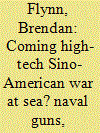| Srl | Item |
| 1 |
ID:
179964


|
|
|
|
|
| Summary/Abstract |
In an era of cyber threats, drones and artificial intelligence, will the future of inter-state warfare at sea inevitably be high tech? This paper challenges assumptions about the ubiquity and importance of high technology in any future naval clash between China and America. While taken as a given that the most advanced weapons and platforms will be vital to such a conflict, both navies also employ legacy weapons and older technologies. A case study is offered here of medium calibre naval guns, seen on the very latest naval surface combatants of both China, the USA, and other major navies. Why do modern navies persist with such seemingly old weapons? To what extent are they likely to be important in any future conflict? It is argued that overly focusing on the latest high-tech weapons risks a type of naïve technological determinism and obscures how high- and low-tech weapons are often complementary. It is this synergy that requires greater understanding and attention. Moreover, relatively low-tech weapons like guns could be surprisingly relevant in the context of hybrid and amphibious warfare scenarios involving China and the USA, especially for the diplomacy of the “shot across the bows”.
|
|
|
|
|
|
|
|
|
|
|
|
|
|
|
|
| 2 |
ID:
190448


|
|
|
|
|
| Summary/Abstract |
This paper examines four of Europe’s more marginal military institutions that receive less attention: the Franco-British Combined Joint Expeditionary Force (CJEF); the French led European Intervention Initiative (EI2); the British led Joint Expeditionary Force (JEF); and the Polish, Lithuanian and Ukrainian joint brigade (LITPOLUKRBRIG). These are described here as “interstitial” because they exist in the niches between both the main multilateral security forums (NATO, EU, UN, OSCE) and the national level. They are intermediaries, working like bridges to cover political obstacles, while often borrowing resources from established actors (notably NATO). It is argued here that such institutions are a form of national hedging against institutional blockages within NATO/EU while providing a platform for national defence policy entrepreneurship. In the context of Cold War 2.0 and Russia’s invasion of Ukraine, such institutional practices should not be dismissed as marginal. They offer a means to deploy European military forces outside formal NATO or EU decision-making structures, a feature which confers a useful flexibility. (161)
|
|
|
|
|
|
|
|
|
|
|
|
|
|
|
|